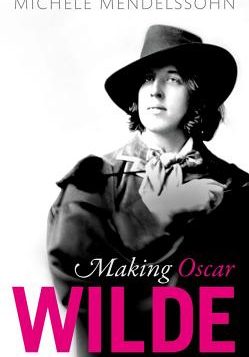 Making Oscar Wilde
Making Oscar Wilde
by Michèle Mendelssohn
Oxford. 360 pages, $24.95
WHEN OSCAR WILDE graduated from Oxford, he had no idea what he wanted to do in life; all he knew was that he wanted to be famous—“and if not famous,” he said, “I’ll be notorious.” Even after winning the Newdigate Prize for poetry at Oxford and taking a First in Greats (the Greek and Roman classics), his application for a fellowship in classics and archaeology was turned down. So he moved to London and tried to make a living as a critic, going to galleries, parties, being amused and amusing. But everyone was still wondering: what does he do? The play he’d written about Russian revolutionaries, Vera, or the Nihilists, was so bad nobody would put it on, so in effect he was unemployed.
Nevertheless, people began to see him as the leader of the Æsthetic Movement—which had actually been created a generation earlier by people like John Ruskin, William Morris Hunt, the pre-Raphaelites, and Walter Pater. None of them, however, wanted to be its leader. But Wilde had attended both Ruskin’s and Pater’s lectures at Oxford. He was, in a way, the bridge between the two—between Ruskin’s belief that art must have moral content and Pater’s espousal of art for art’s sake. A slim volume of poems Wilde published after graduation, more Pater than Ruskin, had been roundly panned for its decadent tone. And when George du Maurier decided to make fun of the Æsthetes with caricatures in Punch, it was Wilde he used as a model. So by the time Gilbert and Sullivan wrote Patience, the operetta that satirized the Æsthetic Movement, Wilde was the inspiration for a character named Bunthorne. And that’s why Oscar Wilde went to the United States in 1882. That was the year the impresario Richard D’Oyly Carte decided that sending Wilde to the U.S. would drum up publicity for the American tour of Patience, and Wilde, having no other source of income or prospect of employment, agreed to go.
Thus begins Michele Mendelssohn’s astonishing demonstration that just when you thought you knew everything about the life of Oscar Wilde, there’s more. Making Oscar Wilde turns out to be not just about Wilde, however; it’s about the U.S. at a time when when P. T. Barnum was drawing them in with exhibits like “The Wild Man of Borneo,” minstrel shows were exceedingly popular, and Darwin’s idea that we are descended from apes was on everyone’s mind. It was a time when people paid money to attend lectures, producers were becoming skilled in the art of publicity, and the press was discovering the power of the interview. It was also a time when a flood of immigrants was so threatening to the Anglo-American majority that “Paddy” (the stereotypically shiftless, drunken, violent Irishman) was considered, along with the poor, illiterate, and formerly enslaved Negro, to be closer to the apes than to themselves.







